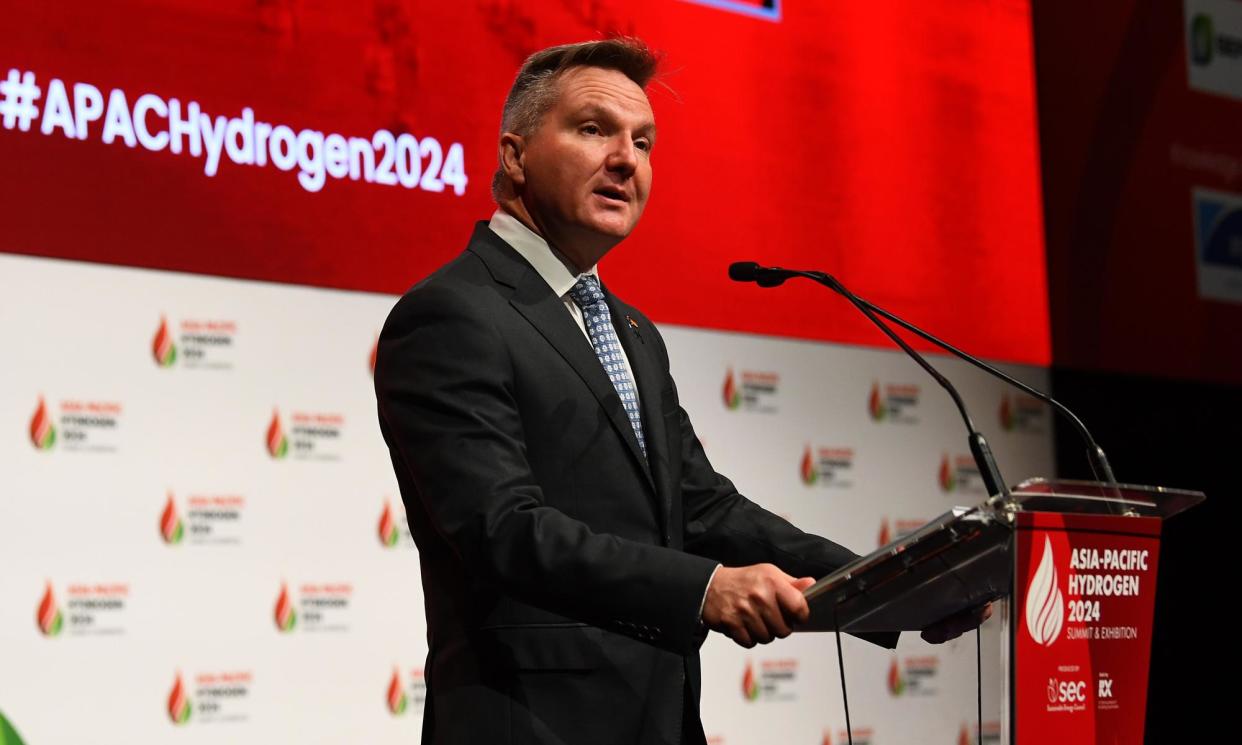Labor’s new ‘renewable hydrogen’ targets aim for Australia to produce 15m tonnes by 2050

The Albanese government has set annual targets of at least 15m tonnes of “renewable hydrogen” by 2050 and dismissed critics who had “gloated” about setbacks to the nascent industry.
The energy minister, Chris Bowen, said on Friday that Australia’s green hydrogen pipeline of projects was “alive and healthy” as he released the government’s new hydrogen production strategy, which updates the 2019 plan he inherited from the Coalition.
The plan aims for annual exports alone of 200,000 tonnes of exports by 2030, with a “stretch” goal of 1.2mt/year by then.
“Setting an early export target provides a strong signal of Australia’s intention to continue supplying energy to the global market,” the report stated. “This matches the ambition of some of our existing trade partners who already have 2030 hydrogen targets.”
By 2050, Australia will target production of hydrogen made from renewable energy of at least 15mt/year, or as much as twice that.
Hydrogen use is aimed at aiding decarbonisation efforts of industry and transport that may not be easily switched to electricity. If the 2050 targets are achieved, between 93mt-186mt of carbon-dioxide emissions will be avoided, according to the strategy.
“In a few short years, the world has committed to monumental investments in hydrogen,” Bowen told the Asia-Pacific Hydrogen Summit 2024 in Brisbane. “We weren’t going to leave Australia’s green hydrogen potential to drift behind in this environment.”
The chief executive of the Australian Hydrogen Council, Fiona Simon, said the national strategy was “quite an evolutionary step” for the sector.
The industry is “definitely not withering on the vine”, Simon said: “We are absolutely moving ahead”.
Billionaire Andrew Forrest announced in July that he would scale back his green hydrogen ambitions as part of a company-wide restructure that cut 700 jobs. The challenge, for any company, is to lower costs so it can compete both with fossil fuels that hydrogen would supplant, and the hydrogen production using energy sources such as gas.
But the government’s updated strategy cites estimates by the International Energy Agency that hydrogen demand will grow to between 250mt/year or as much as 420mt, if net zero emissions pathways are pursued. The latter is about four times the current demand.
In the wake of Forrest’s cuts, Bowen said, “some commentators and some politicians” in Australia had prematurely declared the sector “dead”.
“They’ve celebrated in it. Gloated about any delay, any setback,” he said. “This says more about them and their climate inactivism than it does about Australia’s green hydrogen pipeline.”
Related: Is Andrew Forrest’s energy dream in peril? The future of green hydrogen in Australia explained
The Albanese government has earmarked $4bn for so-called “head start projects” and an additional $8bn over the coming decade to subsidise production. On Friday, it announced a $660m venture with Germany to develop green hydrogen, with Australia’s share paid for using head start funds.
“Disruptions in global energy trade, highlighted by Russia’s illegal invasion of Ukraine, have underscored the value of new and more resilient clean energy supply chains, of which Australia is well placed to play a part,” Bowen said in a joint statement with his German counterpart, Robert Habeck.
Absent from the strategy, though, was mention of a controversial $500m Victorian plan to produce hydrogen from emissions-heavy brown coal for export to Japan.
Guardian Australia has reported both commonwealth and Victorian governments were asked to provide “multiples” of the $50m each had already invested. The Japanese partners in the Suiso Energy project had also been unwilling to commit to import the product beyond the first few years of operations.
Suiso and the two governments were approached for comment.
• This article was amended on 13 September 2024 as an earlier version misnamed Fiona Simon as Fiona “Scott”.


